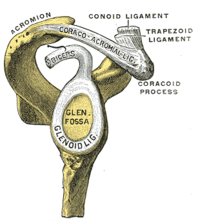
Photo from wikipedia
Background: Superior labrum from anterior to posterior (SLAP) lesions represent a significant cause of shoulder pain and disability among active duty members of the US military. However, few data exist… Click to show full abstract
Background: Superior labrum from anterior to posterior (SLAP) lesions represent a significant cause of shoulder pain and disability among active duty members of the US military. However, few data exist regarding the surgical management of type VIII SLAP lesions. Hypothesis: We hypothesized that arthroscopic repair would decrease pain and increase function at the midterm follow-up and allow for a high rate of maintenance of active duty status. Study Design: Case series; Level of evidence, 4. Methods: Consecutive active duty military patients were identified from January 2011 through June 2015 who underwent arthroscopic repair of type VIII SLAP lesions performed by a single surgeon. Patients were excluded if they underwent glenoid microfracture, other capsulolabral repair, or rotator cuff repair. Outcome measures were completed by patients within 1 week before surgery and at latest follow-up: pain visual analog scale, Single Assessment Numeric Evaluation, American Shoulder and Elbow Surgeons shoulder score, and Rowe instability score. Results: A total of 30 patients met the inclusion criteria for the study. The mean ± SD follow-up was 96.60 ± 10.91 months. At final follow-up, the mean visual analog scale score improved from 8.17 ± 1.6 to 1.63 ± 1.90 (P < .0001), the Single Assessment Numeric Evaluation score from 41.65 ± 16.78 to 87.63 ± 13.02 (P < .0001), the American Shoulder and Elbow Surgeons score from 36.47 ± 10.26 to 88.07 ± 13.94 (P < .0001), and the Rowe score from 35.33 ± 6.56 to 90.00 ± 14.68 (P < .0001). Three patients reported postoperative complications, and 1 progressed to further surgery. Overall, 90% of patients remained on active duty military service and were able to return to preinjury levels of work and recreational activity. The failure rate, defined as persistent instability or activity-limiting pain, was 10%. Conclusion: The results of this study demonstrated favorable outcomes for the majority of patients after arthroscopic repair of type VIII SLAP lesions at midterm follow-up, supporting repair as a viable treatment option for type VIII SLAP tears in this patient population.
Journal Title: Orthopaedic Journal of Sports Medicine
Year Published: 2022
Link to full text (if available)
Share on Social Media: Sign Up to like & get
recommendations!